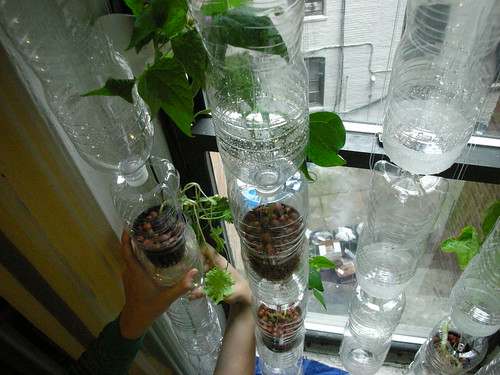
Who would the window farm best be suited for?
Window farms are most appropriate for use in small living spaces or offices buildings with south facing windows. The concept was designed to incorporate vertical space that may not be utilized in a small living area to allow users to grow food and control the amount of water and nutrients that go into food production without the need for harmful chemical fertilizers and can be cultivated year round with little maintenance. Vertical gardens are best suited to aid working families, the financially challenged active seniors, those who don’t have access to fresh affordable food or conscientious consumers who want to save on retail and energy costs who are interested in producing fresh affordable foods in order to enhance the quality of nutrients found in their diets without the use of toxic chemicals or preservatives. Those who may be sensitive to food additives or cannot always afford to buy medicinal herbs or find the cost of organic vegetables too expensive would also benefit from this low cost method of this sustainable method of indoor farming.
Because of the growing crisis of oil scarcity and energy dependency, indoor urban horticulture eliminates the need for consumers to rely upon an energy dependent distribution system which often restricts access to healthy food from those in the lower economic bracket who may not be able to afford healthy, chemically safe food. As many foods often travel a distance of over 1500 miles before it reaches the tables of those who live in urban residences, this method of indoor agriculture also serves to reduce dependency upon the current fossil fuel based distribution system by lowering the overall cost incorporated into the current retail pricing of producing food. In short, indoor urban horticulture and the development of window farming provides a more equitable and energy efficient model that can be used to ensure that those who need access to proper nutrition in their diet can receive the help that they need at a minimal cost. By increasing access to healthy food, those who integrate this method of sustainable agriculture can not only reduce food costs, but are also provided with a healthy conduit to ensure that they can prevent many of the health problems associated with poor diet, malnutrition and provides more economic equity by allowing those who could not otherwise control the means of production. This method of sustainable urban horticulture will also allow more individuals to establish social and financial autonomy by learning how not to become so reliant upon government agencies or corporations to control food costs and increases the benefits of proper nutrition and health maintenance by learning how to control the means of their own production through the cultivation of their own healthy and affordable food.
 Background
BackgroundThe Project was started by artists Britta Riley and Rebecca Bray in February, 2009 through an artist's residency at Eyebeam Art and Technology Center in New York and sponsorship by Submersible Design, Riley and Bray's interactive design firm. Riley continues to drive the project at Eyebeam with a team of volunteers and the participation of hundreds of window farmers worldwide
Windowfarms: Growing Food Year-Round in Inner City Buildings
Researchers have argued that to grow some of his own food is the most effective action an individual can take for environment, not only because of the food industry’s heavy carbon footprint but also because participating in agricultural production cultivates a valuable skill set around sustainability issues.
Many neighborhoods (particularly low income ones) in cities around the world are considered food deserts, meaning little fresh food is easily accessible. Residents tend to consume processed, packaged, and canned food having depleted nutrients.
Few other projects provide opportunities for such direct personal involvement, make this productive use of existing construction, or so directly target urban dwellers estranged from agricultural issues.
Inner city dwellers can grow their own food in their apartment or office windows throughout the year by means of these elegant, inexpensive, vertical, hydroponic vegetable gardens made from recycled materials or items available at the local hardware store. The first system produced 25 plants and a salad a week in mid winter in a dimly lit 4’ x 6’ NYC window.
 R&D-I-Y: Mass Collaboration to Solve Environmental Problems
R&D-I-Y: Mass Collaboration to Solve Environmental ProblemsThe ultimate aim of the Windowfarms project, however, is not to create a perfected physical object or product. Rather, the most highly valued result is a rewarding experience with crowds sourced innovation. We are interested in the participants’ experience as they design for their own microenvironments, share ideas, rediscover the power of their own capacity to innovate, and witness themselves playing an active role in the green revolution.
The window farms project approaches environmental innovation through web 2.0 crowd sourcing and a method called R&D-I-Y (research and develop it yourself). Big Science’s R&D industry is not always free to take the most expedient environmental approach. It must assume that consumers will not make big changes. Its organizational structure tends toward infrastructure-heavy mass solutions. A distributed network of individuals sharing information can implement a wide variety of designs that accommodate specific local needs and implement them locally. Ordinary people can bring about innovative green ideas and popularize them quickly. Web theorists claim that this capacity to “organize without hierarchical organization” will be a fundamental shift in our society brought about by the web over the coming decades.
After only 7 months and only $5000 in funding the project has already been widely acclaimed and supported with features in Grist, Art in America, Wired Blog, Ready Made magazine, prominent food blogs, and upcoming documentary films. Hundreds of thousands of hits have come in to the site from IP addresses worldwide. The participating public has submitted 29 unique viable design improvements.
Why is it useful?
- Produces approximately 20 times the normal production volume for field crops.
- Requires 5% of the normal water requirements for field crops
- Can be built on non arable lands and close to major city markets
- Can work in a variety of environments: urban, suburban, countryside, desert, etc.
- Does not use herbicides or pesticides
- Will have very significant operating and capital cost savings over field agriculture
- Will drastically reduce transportation costs to market resulting in further savings, higher quality and fresher foods on delivery, and less ransportation pollution
- Will be easily scalable from small to very large food production situations (Laumer)
Where can I install it?
Hydroponic gardens can be designed to suit multiple functions. They are appropriate for installation in a variety of spaces; indoors: in window sills or wall installations, or outside on rooftops and outdoor as a modular patio garden. In some cases can installations can even be modified to utilize rainfall by installing as part of a gutter rain cache system used to maximize growth with fresh water yields.
 This is a balcony garden used with kitchen compost that was designed as a wall installation
This is a balcony garden used with kitchen compost that was designed as a wall installation
This HDVG or High Density Vertical Garden "...is designed to grow vegetables and other foods much more efficiently and with greater food value than in agricultural field conditions."
Australian Artist Joost Bakker uses leaf and flower, raw steel and discared objects among his construction materials- "I'm not really into luxurious finishes, I like using things that people perceive as ugly." Jorge at Inhabitat notes such systems are great in small spaces: "the perfect backdrop for any office or apartment that needs and extra bit of greening but can’t afford the space required for them (when you can’t build out, build up!)
Designed by Ontario College of Art and Design student, Michael Tampilic, the Vert is a self-contained vertical garden terrace that stores rainwater for irrigation. The Vert is connected to a downspout; water then passes through a filter and is stored in an ample tank to water plants over an extended period of time. To prevent debris and mosquito larvae, the filter box contains a micron mesh screen. Cotton wicks pull stored water up - through capillary action - to nourish the plants. Any overflow from the tank is diverted back through the downspout.

This installation was incorporated into an office space. The goal of the installation was to increase retention and reduce sick days.
What do we really need to know about food security?
In this video, noted Physicist, social activist and environmentalist Dr. Vandana Shiva discusses how activists in India have addressed the issue of how the act of creating food locally ensures food security and reduces the poverty created by the impacts of current global distribution system that led to the global food crisis.









No comments:
Post a Comment